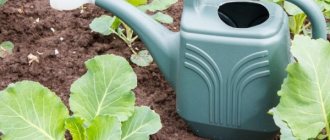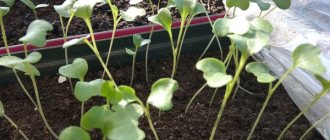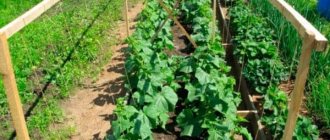Cabbage is a versatile and very healthy vegetable that is famous for its antioxidant and anti-cancer properties. It is eaten raw, pickled and fried, and is suitable for making stews, salads, vegetable soups and pies. But in order to treat family members with these dishes, the farmer needs to master the agricultural technology of growing cabbage. It is also important to properly prepare the garden beds before planting seedlings. In this matter, the vegetable grower will be helped by green manure for cabbage - special industrial crops that help enrich the soil before planting seedlings in open ground. We will talk further about which green manure crops are best to sow to achieve maximum cabbage yield.
What are green manures?
Green manures are certain plants that saturate the soil with nutrients . This concept appeared at the end of the 19th century; The first to speak about it was the Frenchman, the botanist J. Ville.
Interesting! The concept itself appeared in the 19th century, but farmers used this property of some plants long before that.
Scientists are confident that using green parts of plants to nourish the soil is in no way inferior to applying fertilizers in the form of manure . Initially, the green part of the plants was torn off and dug up with soil. Now this process has been simplified and plowing is carried out without tearing out the vegetative mass.
What are they needed for
You need to understand what plants do and what benefits they provide:
- maintain normal temperature, humidity and protect the soil from drying out;
- prevent the destruction of the humus layer, the formation of erosion and dry crust;
- make the soil structure loose and breathable, facilitating the passage of water;
- saturate with organic components;
- increase the growth of beneficial bacteria and relieve soil fatigue;
- reduce acidity levels;
- reduce the number of weeds, reduce the likelihood of pests;
- The highly branched root system of plants “pulls up” mineral substances from the deep layers of the soil, raising them to the surface.
Thanks to green manure plants, it is possible to improve the health of the soil , give it looseness and saturate it with microelements from deep layers. The need to apply chemicals is reduced and the quality of the crop is improved.
What vegetables should not be planted?
It is strongly not recommended to plant any types of cruciferous vegetables after cabbage (especially early-ripening white cabbage and cauliflower), especially if there are certain concerns about the penetration of fungal diseases into the soil. You should definitely not choose vegetables such as:
- radish (including daikon);
- turnip;
- rape;
- radish;
- swede;
- watercress;
- mustard crops.
Related article:
How to make a warm bed for cucumbers
Strawberries, beets and peas can definitely be called some of the worst successors.
Pathogenic bacteria and pests that remain on the unharvested roots of heads of cabbage at a depth of up to 60 cm and in adjacent areas can completely destroy the crop yield.
Advantages and disadvantages of using green manure
In addition to great benefits for the soil, green manure has other positive qualities :
- they are cheap;
- natural and safe for animals and humans, as well as beneficial microorganisms;
- Overdose is impossible.
Despite the abundance of positive qualities, there are, albeit minor, disadvantages . These include high labor intensity. Also, when growing simultaneously with garden plants, green manure will compete for a place in the sun.
Interesting things on the site:
How and when to mow oats as green manure
Why rye is good as green manure in the fall
The best green manure for cucumbers in the fall
The best green manure for cabbage in the fall
If you plan to sow cabbage in the spring, you should choose green manure that will benefit this particular garden crop.
Interesting! More than 300 plants are considered green manure, but there are the most popular ones. Also, different ones will be useful for different garden crops.
Beans
It is this plant that saturates the soil with nitrogen and retains it in it . Beans lighten the soil and improve its structure. It is worth noting that the seeds of this plant are expensive, so it is important to evaluate the feasibility of such agricultural technology. It may be worth considering other options.
Clover
The perennial green plant has small tubers on its roots that contain bacteria . Thanks to this property, a special, unique effect on the soil is obtained. The plant increases the organic content in the soil and saturates it with nitrogen. Clover protects the earth from erosion.
Seeds are sown in the ground in late summer or early autumn . The soil is dug up before flowering begins. You can pick off the green mass and mulch the surface of the earth; this application will also give a good result.
Alfalfa
An unpretentious plant that also enriches the soil with substances useful for cabbage . Approximately 2 kg of seeds per hectare of land are sown. Depending on the condition of the soil, the amount may vary at the discretion of the gardener.
Rye
This green manure not only provides the soil with minerals and vitamins for cabbage, but also protects it from the growth of various weeds. Growing rye between cabbage rows is the most effective solution. The amount of time for caring for a cabbage bed is reduced to a minimum.
Sochevichnik and others
Another legume crop is sochevichnik. Its seeds are also expensive, but the benefits are obvious . A large amount of greenery brings undoubted benefits to the soil and future cabbage, but it should be taken into account that this plant is whimsical and does not grow in every area.
Lupine is a good green manure for cabbage . The plant itself is very rich in minerals, which is undoubtedly beneficial for the soil. The seeds are cheap, grow quickly and are completely unpretentious. Lupine can change the acidity of the soil and normalize pH levels.
Sweet clover is suitable for highly acidic soil . It reduces the likelihood of pests and reduces the number of weeds.
Phacelia is unpretentious, grows quickly and deoxidizes the soil . There is a high probability that after this green manure the cabbage will not get sick.
Reference. There are a number of other plants that are used much less frequently. Many of them are soil selective or the seeds are not available in our country.
The best neighbors for culture: options for joint planting
Potatoes grow well next to cabbage . Good neighbors and crops such as onions, dill (Latin Anethum), beans (Latin Phaseolus). Don’t forget about marigolds (lat. Tagetes) - these are the best flowers to plant with cabbage. They drive away pests from it.
Important! Joint planting with cabbage is justified for those plants that, like it, love abundant watering. This is lettuce and onions.
What pests should you protect cabbage from is flea beetles. It is she who gnaws through the leaves of the plant, making a literal sieve out of them. So, one simple method will help you make the flea pass by - plant strong-smelling plants or flowers near the vegetable. These can be garlic, coriander and saffron. If the weather is good and the crop is properly cared for, you can plant eggplants, peppers and legumes next to it. Chinese cabbage will also be a good neighbor. Sage, mint and thyme are also great options. And dill can even scare away aphids from vegetables.
Marigolds are the best flowers to plant with cabbage
The best green manure after cabbage in the fall
After growing cabbage, the soil needs to recover, which means planting other plants is required . These green manures cannot be planted before cabbage, but after that is just the right time. They will help the land get back what was depleted during the growth of the main crop.
Mustard
At the beginning of autumn, white mustard is sown. It prevents nitrogen from evaporating and nourishes the earth . A positive quality of the plant is its rapid growth and resistance to cold. Do not use in acidic soil or wetlands.
Rape
The crop is demanding on the composition of the soil; most of all, it does not tolerate high humidity . It is better to sow at the end of summer. Rapeseed takes about 60 days to grow. This crop requires care and does not tolerate frost and sudden changes in temperature.
Winter rye
One of the best green manures after cabbage is winter rye. Sown after harvest, it manages to gain green mass before frost. Having easily endured the winter, it continues to grow in the spring. The plant is not demanding in terms of soil composition or care. The only drawback is that it cannot retain nitrogen in the soil.
Buckwheat
This green manure should not be sown for the winter - buckwheat needs about three months, before winter it will not have time to grow green mass. The sprouts are buried in the ground when flowering begins. Buckwheat is undemanding to soil composition. Capable of converting phosphorus into an accessible form for other crops. Buckwheat seeds are difficult to obtain.
Oilseed radish and others
The cruciferous plant is sown at the end of August . It helps a lot on heavy soils, making them lighter. You need few seeds, it grows quickly and is not afraid of frost. Plant in the ground before flowering.
Mouse peas saturate the soil with nitrogen and organic matter and prevent weeds from growing. But this type of green manure is capricious, does not like dryness and prefers slightly acidic soils. Helps get rid of snails and slugs.
It can be useful:
What to plant after pepper next year
What to plant after pumpkin next year
What to plant after carrots next year
White mustard
Mustard is famous for its ability to attract beneficial insects and repel pests, so it is familiar to almost every gardener as a green manure. Among its main characteristics:
- Frost resistance;
- Quick set of green mass;
- Powerful root system that loosens hard soil;
- Production of organic substances that saturate the earth with nitrogen and phosphorus.
Followers of white mustard can be berries, herbs, bulbous flowers, and vegetables. It is not recommended to plant radishes, radishes and cabbage in areas fertilized by mustard mowing.
What green manures cannot be sown before and after cabbage
To get a good cabbage harvest, you should remember the rules of crop rotation . This also applies to green manure. Since cabbage belongs to the cruciferous plant family, you should not use green manure from the same family before planting it.
You should also take into account some plant characteristics . For example, rye dries out the soil, but cabbage does not like this at all. For cabbage, you should choose green manure that will enrich the soil with nitrogen.
Interesting! Gardeners often use mixtures of several green manures. One of the popular compositions is phacelia with sweet clover and bruise. The sweet clover is taken in two parts, and the rest – one at a time.
Cabbage greatly depletes the soil, so after it it is imperative to sow plants that will restore the soil. Split peas in combination with oats will help with this.
When to sow green manure
Green manure is sown after harvesting . In most cases, this is done at the end of August - beginning of September. It is necessary to choose plants that will have time to grow green mass before frost, in order to have time to incorporate them into the soil.
When the snow melts, it is good to plant phacelia, which will develop well before the time of planting cabbage in the garden . It is best if the plants grow at the same time. In mid-May, phacelia is cut and laid along the cabbage beds, creating mulch.
After this, it is useful to plant marigolds between the rows, which will repel pests . Often gardeners use calendula or other plants with a specific aroma.
Reference. If cabbage is planted directly into growing green manure, it will hurt less, form larger leaves and grow faster.
Basic principles of crop rotation
The plants in the garden should be alternated correctly. For every plant there are good and bad predecessors. They are planted one and a half months before planting the main crop.
How do you know which plants are good and which are bad for cabbage? To understand this, you need to know what nutrients it takes from the soil. Based on this, it is necessary to alternate it with other crops that require other nutrients.
Cabbage is a crop that has a high nutrient requirement , like pumpkin, potatoes and zucchini, celery and spinach. Cabbage and potatoes can be grown in one place for 2 years, then they should be replaced by other crops.
These can be crops with average nutrient requirements:
- Cucumber (lat. Cucumis);
- Eggplant (lat. Solanum melongena);
- Carrot (lat. Daucus);
- Peas (lat. Pisum);
- Onions (lat. Allium) and herbs.
The presented crops will help restore the nutritional value of the soil. As a result, after them it will be possible to plant cabbage again.
Cabbage is a crop that has a high nutrient requirement
Sowing rules
It is important to know the rules for sowing green manure and vegetable crops. The most important among them :
- plants of the same family have similar diseases, which means they should not be sown one after another;
- It is necessary to embed green manure into the ground before flowering, otherwise they will turn into weeds and cause harm to garden plants;
- You shouldn’t bury green manure very carefully, as this disrupts the porosity of the soil for which they are planted.
It is most correct to cut off the green manure at the root and plant it shallowly or even use it as mulch .










